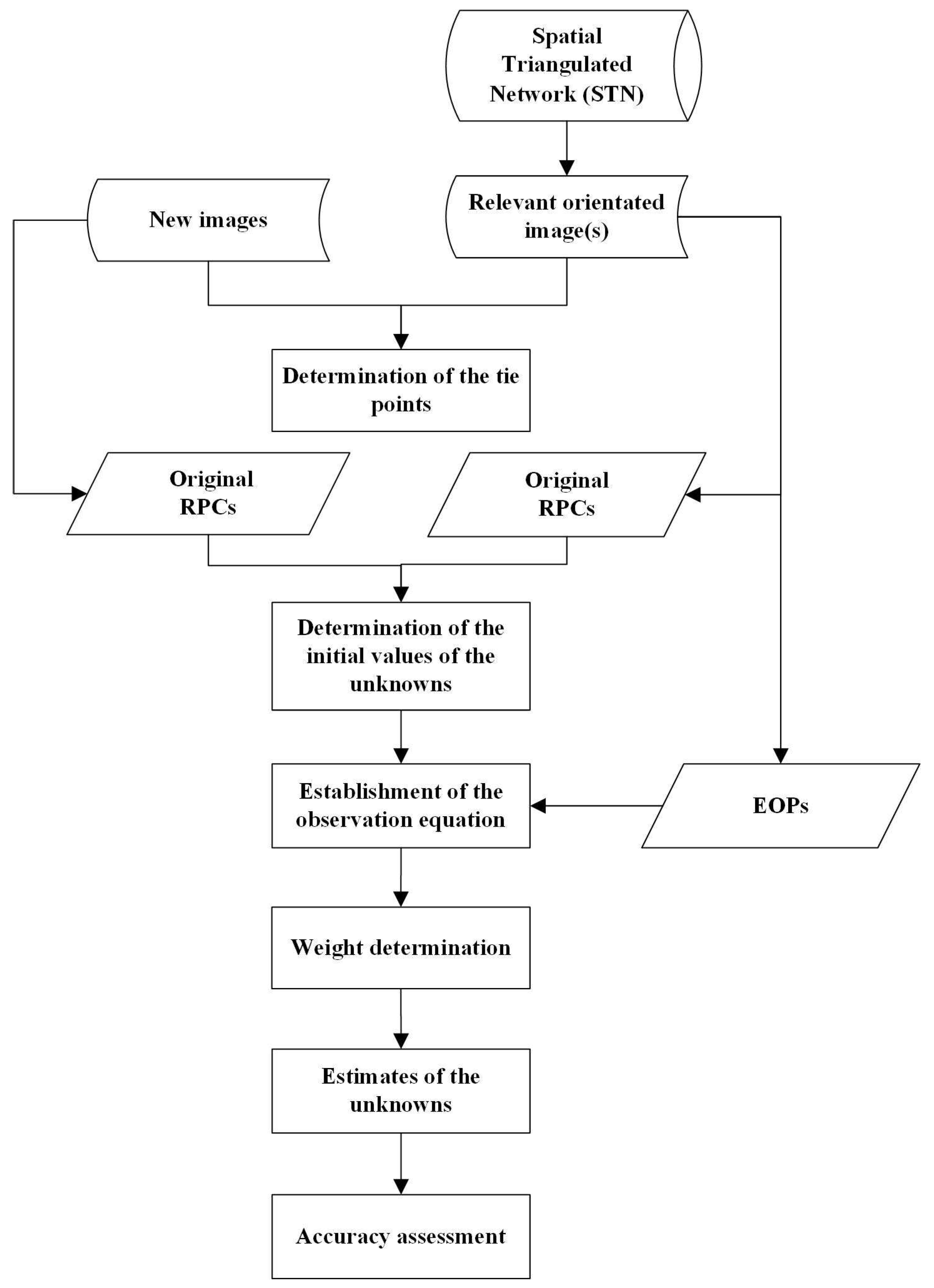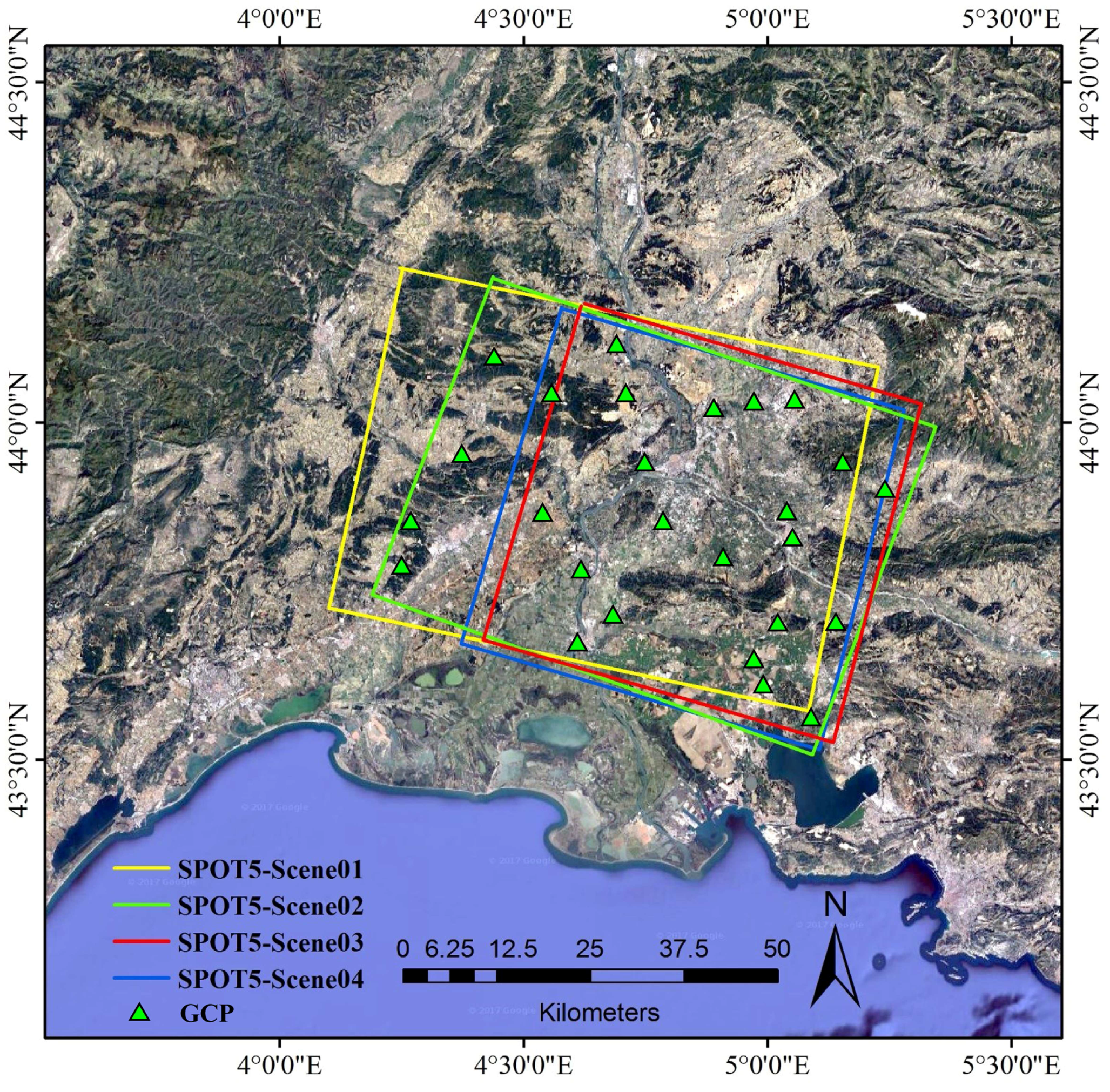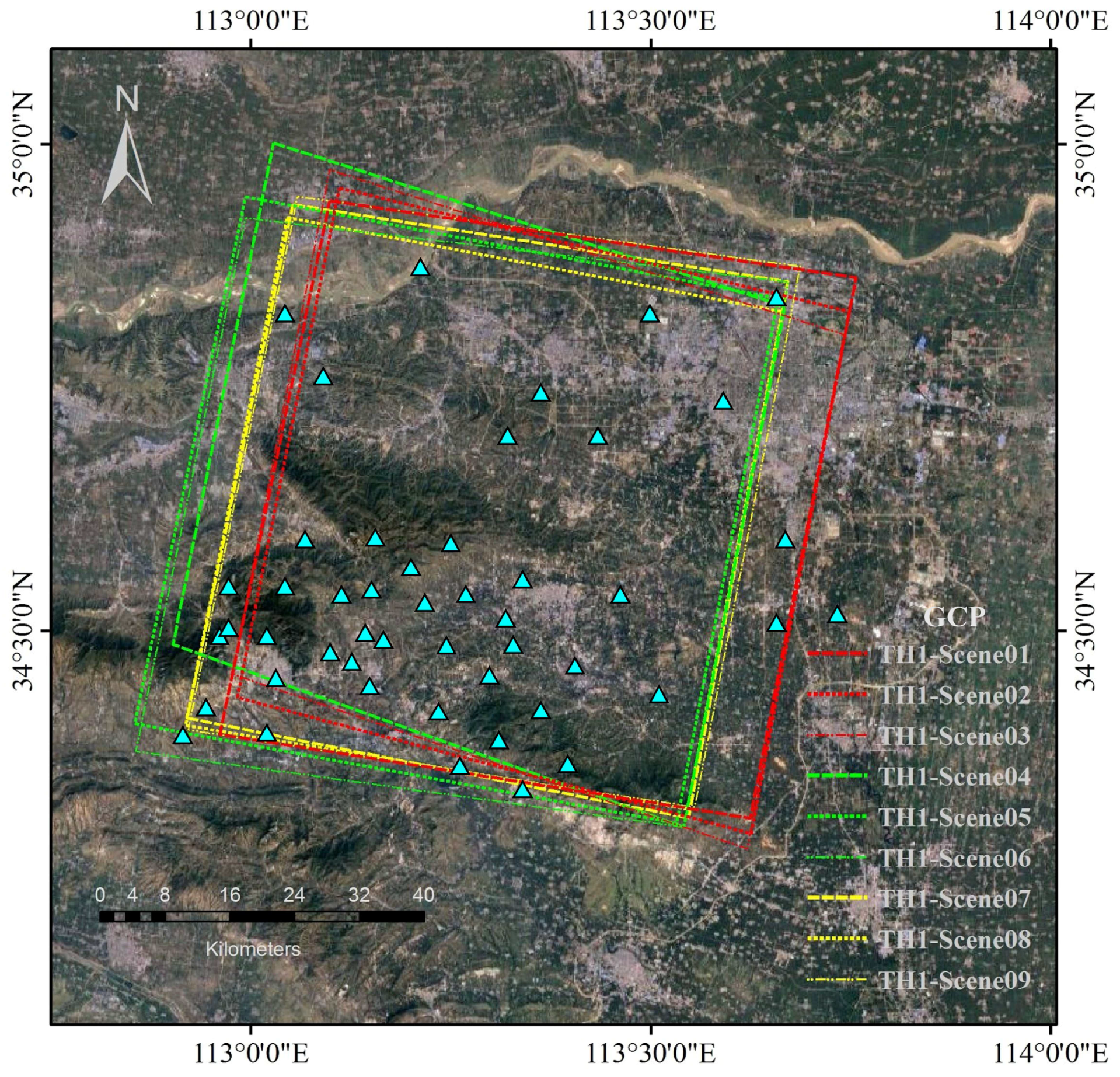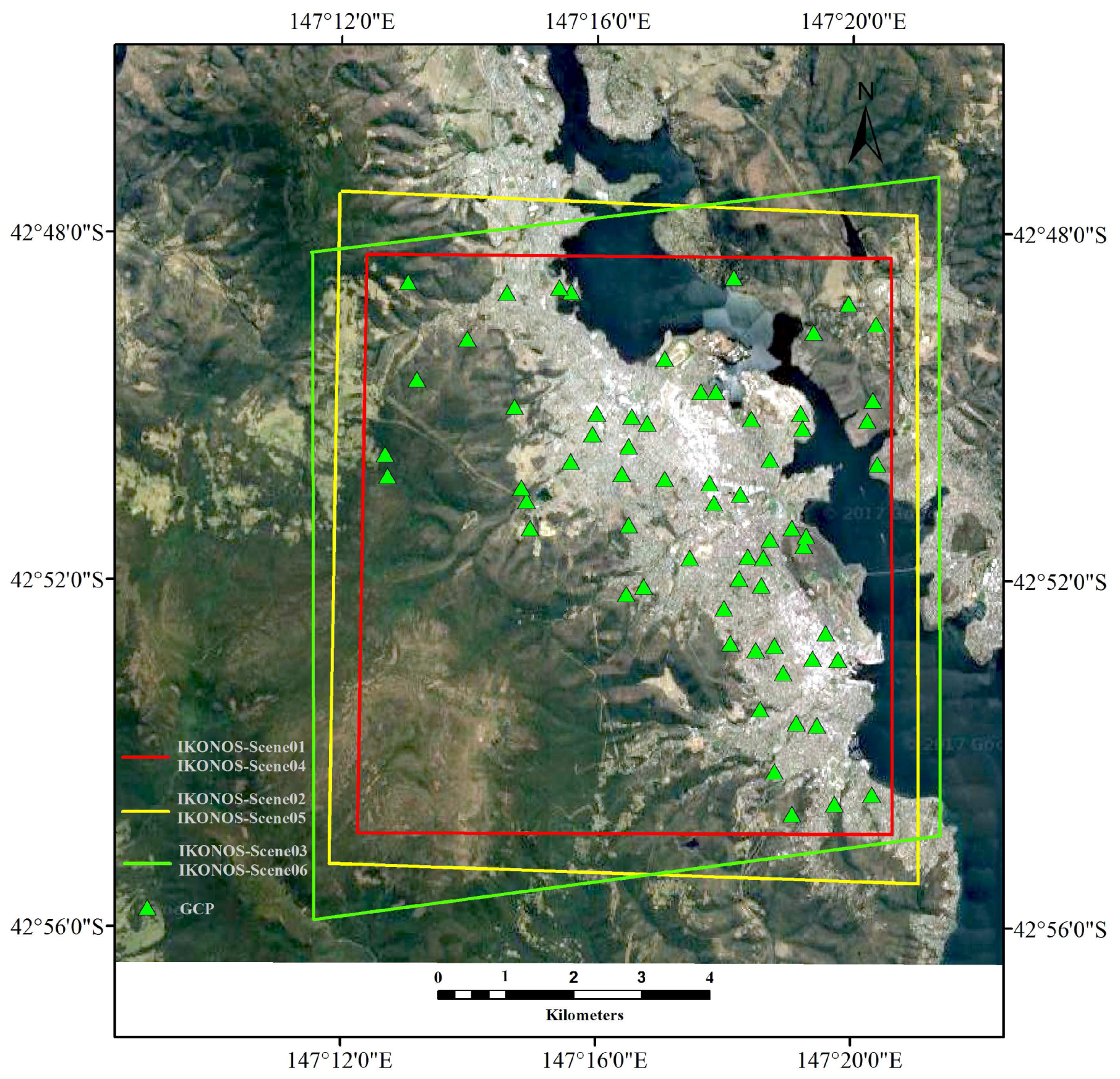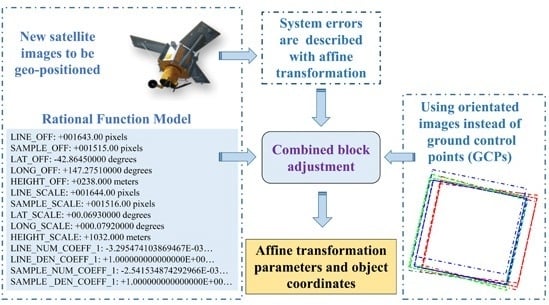3.1.2. The Experimental Results of the SPOT-5 Images
More than 30 tie points were collected on the overlapping areas to perform various tests. The tests were designed, based on the same schemes as in the previous study [
9]. The tests were divided into two groups. In the first group, the new images are SPOT5-Scene01 and SPOT5-Scene02, and they form the base to height ratio of 1.2, the biggest among four images. In the second group, the new images are SPOT5-Scene01 and SPOT5-Scene03, and they form the base to height ratio of 0.6, the smallest among four images. The RFM based direct intersection method, the RFM based block adjustment method and the RFM method with orientated image(s) were performed during various tests and the accuracies of these tests are shown in
Table 2 and
Table 3. The physical model based direct intersection method, the physical model based block adjustment method and the physical method with orientated image(s) had been performed in the previous study [
9] and the accuracies from [
9] are also listed in
Table 2 and
Table 3 for the comparison purpose.
The new images SPOT5-Scene01 and SPOT5-Scene02 were geo-positioned using the RFM based traditional methods: the direct intersection method and the block adjustment method, described as Test A and Test B in
Table 2, respectively. Additionally the new images SPOT5-Scene01 and SPOT5-Scene02 were geo-positioned using the RFM method with SPOT5-Scene03 as the orientated image (Test C), with SPOT5-Scene04 as the orientated image (Test D), and with both SPOT5-Scene03 and SPOT5-Scene04 as the orientated images (Test E), respectively. In Test C and Test D, only one orientated image was introduced in the combined adjustment, and they have different resolutions. Their accuracies are shown in
Table 2. The same tests in
Table 2 had been executed by the physical model based methods with physical coefficients in the previous study, and their accuracies from [
9] are listed in
Table 2 used in order to compare to the RFM based traditional methods and the RFM method.
For the RFM based methods, Test B, which uses the block adjustment method with GCPs, has the highest accuracies in both directions (7.91 m horizontal and 3.12 m vertical). In Test C and D, only one orientated image was introduced in the combined adjustment, and the coefficient matrix of the normal equation was still rank-deficient. An iterative method for correcting characteristic values was used to improve the ill-condition, as described in
Section 2.3. Comparing to the RFM based direct intersection method, the horizontal accuracies of the RFM method are increased from 48.16 m (Test A) to 43.83 m (Test C), 15.80 m (Test D), respectively, and the vertical accuracies for these three cases remain the same (19–24 m). In Test E, two orientated images were introduced in the combined adjustment, and the coefficient matrix of the normal equation was full rank. The horizontal accuracy is 8.74 m, close to the highest horizontal accuracy of the block adjustment method with using GCPs (Test B), however, the vertical accuracy remains near the same (19–24 m) with Test A, C and D.
From the results, it indicates that the RFM method can achieve a reasonable accuracy in the horizontal direction compared to the block adjustment method, and the more high resolution orientated images are used, the more accurate results can be obtained in the horizontal direction. However, the vertical accuracy remains the same with the direct intersection method.
The RFM based geo-positioning accuracies are compared with the physical model based methods. From
Table 2, it shows that: the physical model based direct intersection method achieves a better result than the RFM based direct intersection method (Test A); the physical model based and RFM based block adjustment method give similar results (Test B); and the physical method with the orientated SPOT5-Scene03 (Test C), with the orientated SPOT5-Scene04 (Test D) and with both orientated SPOT5-Scene03 and SPOT5-Scene04 (Test E), achieves better results in the vertical direction than the RFM method does. The RFM method gives better results in Test D and E and worse result in Test C in the horizontal direction than the physical method does.
The comparison results illustrate that RFM based block adjustment method can achieve the similar accuracies with the physical model based block adjustment method. The physical model based direct intersection method is more accurate than the RFM based direct intersection method. The RFM method performs better in the horizontal direction than the physical method, however, the vertical accuracy of the RFM method is worse than the physical method and does not reach the optimal accuracy of the block adjustment method using GCPs. The reasons may be due to the fundamental differences of these two models and/or caused by the varying base to height ratios [
18], and they are going to be investigated next.
The second group of tests were designed to geo-position the new images SPOT5-Scene01 and SPOT5-Scene03 with the slightly weak geometry (a base to height ratio of 0.6) using the traditional methods and the RFM method, their accuracies are shown in
Table 3. The direct intersection method is described as Test A and the block adjustment method is described as Test B, respectively. The RFM method with the orientated SPOT5-Scene02, with the orientated SPOT5-Scene04, and with both orientated SPOT5-Scene02 and SPOT5-Scene04 are described as Test C, Test D and Test E, respectively. Their accuracies of the five tests with the physical model based methods in the previous study from [
9] are also listed in
Table 3 to compare to the RFM based traditional methods and the RFM method.
For the RFM based methods, in Tests C and D, only one orientated image was used to geo-position the new SPOT5-Scene01 and SPOT5-Scene03, and the coefficient matrix of the normal equation remained rank-deficient. The iterative method for correcting characteristic values was used to ensure the stability of the solution. Comparing to the direct intersection method, the horizontal accuracies of the RFM method are improved from 69.42 m (Test A) to 19.57 m (Test C) and 8.20 m (Test D), respectively, and the vertical accuracies are improved from 35.93 m (Test A) to 23.91 m (Test C). The vertical accuracy of Test D decreases to 57.73 m. Test E, which involved two orientated images and the coefficient matrix of the normal equation was full rank, achieves better accuracies than Test B with the block adjustment method with using GCPs.
From the results, it indicates that the RFM method can achieve high accuracies in both horizontal and vertical directions. The more accurate results can be obtained in the horizontal direction when the more high resolution orientated images are used. From the results of Tests C and D using only one orientated image, it demonstrates that the vertical accuracy can be improved while the base to height ratio is increased from 0.6 to 1.2 (Test C) compared to the direct intersection method (Test A); the introduction of orientated SPOT5-Scene04, which has the similar viewing angle of SPOT5-Scene03, does not increase the base to height ratio, in contrast it weakens the geometry with new images SPOT5-Scene01 and SPOT5-Scene03 (Test D), resulting in the worst vertical accuracy. Test E with two orientated images and a biggest base to height ratio performs best in the vertical directions among the five tests. Therefore, it can be said that the vertical accuracy of the RFM method is affected by the base to height ratio.
The accuracies of RFM based methods were compared to the physical model based methods. The physical model based direct intersection method performs better than the RFM based direct intersection method (Test A). The physical model based block adjustment method and the RFM based block adjustment method (Test B) obtain identical results. In Tests C and D, the physical method achieves better results than the RFM method in the vertical direction, however in opposite in the horizontal direction. In Test E, the RFM method obtains the similar accuracy with the physical method.
From the comparison results, it indicates that the physical model based direct intersection method performs better than the RFM based direct intersection method. Both the RFM and physical model based block adjustment methods with using GCPs could obtain similar results. In Tests C and D, the physical method performs better than the RFM method in the vertical direction, especially in Test D, in the case of weak geometry (small base to height ratio), the vertical accuracy with the physical method is still improved comparing with the Test A. Therefore, the RFM method is more sensitive to the base-height ratio in the vertical accuracy. The RFM method and the physical method can obtain the same results with the block adjustment method when more than one orientated images are utilized and the base to height ratio is improved.
In summary, both the RFM based and physical model based block adjustment methods can achieve similar results. Compared to the physical model based method, the RFM method is more sensitive to the base-height ratio in the vertical accuracy. When higher resolution and/or more orientated images are used, the horizontal accuracy of the RFM method can be improved significantly. Therefore, when the RFM method is going to be used and high accuracies are to be expected, it is suggested that more than one orientated image having reasonable strong geometric relationship with the new image(s) should be introduced in the process.
